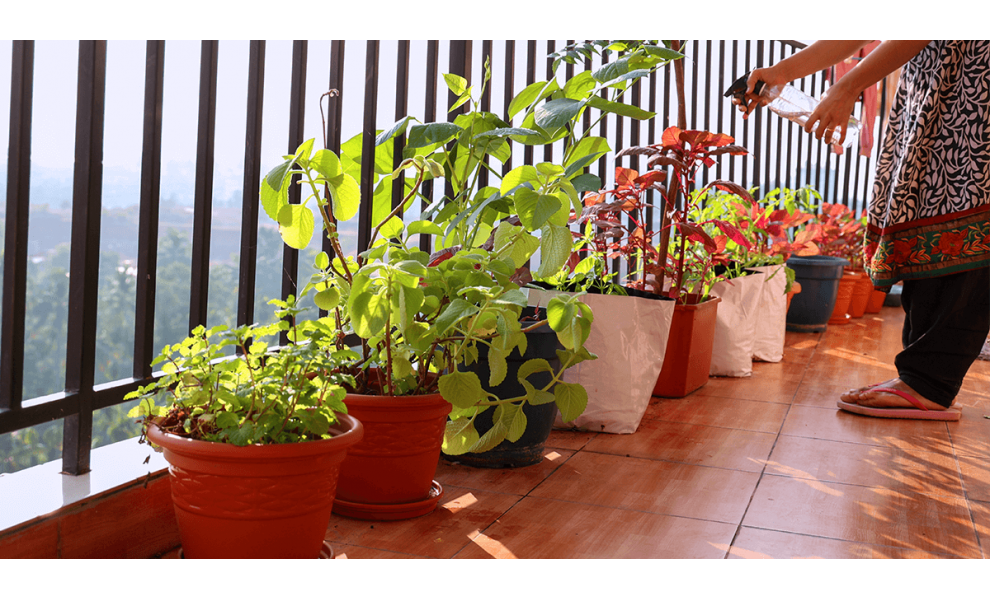22 Jun


Contrary to popular belief, the ability to have a thriving garden is not a magical gift given only to chosen ones. It is a learned practice, with experimentation, making mistakes and killing some plants during the process of learning how to keep them alive. Just as the most experienced drivers occasionally scratch their cars, cooks burn some dishes, and writers constantly re-write, gardening is a leap of faith. The real joy is in the time spent doing it.
With that said, there is a checklist of basics that a beginner needs to be aware of. This article attempts to discuss these in the specific context of the commonly found plight of many Indians who find themselves in large urban settings, living in apartment complexes, without real garden space – and if lucky, with a balcony or two. Balconies are great extensions of a living space and plants make the area more inviting.
Sunlight: Before choosing your plants, watch your balcony for a few days and make a note of the type of sunlight (morning, afternoon, or evening sun – and whether direct or indirect). Keep in mind that the angles and direction of sunlight change during different months of the year. The goal is to select plants that will be
With that said, there is a checklist of basics that a beginner needs to be aware of. This article attempts to discuss these in the specific context of the commonly found plight of many Indians who find themselves in large urban settings, living in apartment complexes, without real garden space – and if lucky, with a balcony or two. Balconies are great extensions of a living space and plants make the area more inviting.
Sunlight: Before choosing your plants, watch your balcony for a few days and make a note of the type of sunlight (morning, afternoon, or evening sun – and whether direct or indirect). Keep in mind that the angles and direction of sunlight change during different months of the year. The goal is to select plants that will be

comfortable with the pattern and intensity of sun that your balcony space receives. Direct morning sunlight for 4 to 5 hours is sufficient for most sun-loving plants. Afternoon sunlight, especially between April and June may be too intense for plants in smaller pots.
Soil: Most plants have roots that require some degree of aeration. The most common cause of plants dying is soil that doesn’t drain well, which leads to root rot. A vicious cycle may begin when an unsuspecting plant parent may notice a plant wilting (from over watering) and then instead of cutting back on water, one waters even more, guaranteeing a mucky death. Always use potting soil which has a good mixture of base soil (loam, or top soil), drainage enabling elements (river sand, dry coconut husk, coco peat or perlite) and nutritional elements (we encourage the use of organic fertilizers based in natural waste such as cow dung, goat and chicken droppings, compost, etc. mixed into the soil itself at the potting stage). With a small thin wooden or metal rod, loosen the topmost inch of soil once every 3 weeks to ensure good drainage and allow the roots of your plants to breathe.
Water: The amount of water depends on the size and depth of the pot, the size of the plant and the type of soil you have used, the time of the year and of course, the type of plant. Adeniums and bougainvillea prefer dry conditions and do not flower when watered too much. Orchids need moisture regularly, but can easily rot if the roots are always wet. A general rule of thumb is to water only when you find the top
Water: The amount of water depends on the size and depth of the pot, the size of the plant and the type of soil you have used, the time of the year and of course, the type of plant. Adeniums and bougainvillea prefer dry conditions and do not flower when watered too much. Orchids need moisture regularly, but can easily rot if the roots are always wet. A general rule of thumb is to water only when you find the top

soil dry. If moist, do not water as this indicates that the soil still has sufficient water for the plant. This may translate to watering twice a day during May, or once every two days in January. Always buy pots that have one or more drainage holes at the bottom so excess water drains away. Standing water at the bottom of a pot cannot be seen and is surefire way to kill any plant. Never water when the sun is up – this will burn the leaves, water instead early in the morning or in the evening when heat levels are low. During the monsoon, despite your plants being out of the reach of direct rainfall, may absorb sufficient moisture from the spray outside and thus do not need to be watered for longer periods of time.

Plant Selection: There are a large number of plants that are suitable for balconies. Below is a list that has been organized based on the amount of sunlight you have available on your balcony.
For those with at least 4-5 hours of direct morning or afternoon sun, bougainvillea are hardy plants that do well without too much water. If one has a trellis where creepers can grow onto, passionflowers and butterfly pea flowers do well. Crotons, jasmine and periwinkles will add color to the space. Edibles such as tulsi, pudina, lemongrass, curry patta, tomatoes,
For those with at least 4-5 hours of direct morning or afternoon sun, bougainvillea are hardy plants that do well without too much water. If one has a trellis where creepers can grow onto, passionflowers and butterfly pea flowers do well. Crotons, jasmine and periwinkles will add color to the space. Edibles such as tulsi, pudina, lemongrass, curry patta, tomatoes,

chillies and lemon plants work well but require a decent amount of sunlight.
For balconies with partial shade or indirect light, dieffenbachia, syngoniums, zamioculas, rhapis palms, sansevierias, pothos, spider plants and aglaonemas are suitable. For the bold, orchids, though challenging to maintain, can be very fulfilling, especially when they bloom.
Balconies, depending on the environment, may attract annoyances such as crows who may try to pull off branches, the occasional rodent who may proceed to dig up and eat the seeds that you just planted, or even the adventurous squirrel who may chew up your electrical wires. Also, beware of the unassuming neighbor on the top floor who washes his balcony and throws water down onto yours and into your plants. Plan your layout accordingly, think about bird nets, and have a system of drainage that allows your space to remain clean and dry.
For balconies with partial shade or indirect light, dieffenbachia, syngoniums, zamioculas, rhapis palms, sansevierias, pothos, spider plants and aglaonemas are suitable. For the bold, orchids, though challenging to maintain, can be very fulfilling, especially when they bloom.
Balconies, depending on the environment, may attract annoyances such as crows who may try to pull off branches, the occasional rodent who may proceed to dig up and eat the seeds that you just planted, or even the adventurous squirrel who may chew up your electrical wires. Also, beware of the unassuming neighbor on the top floor who washes his balcony and throws water down onto yours and into your plants. Plan your layout accordingly, think about bird nets, and have a system of drainage that allows your space to remain clean and dry.



